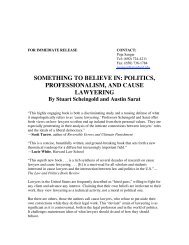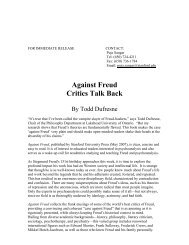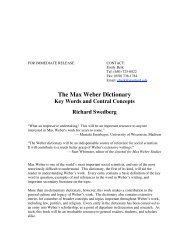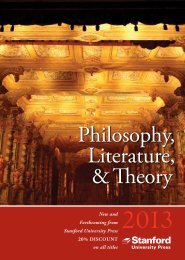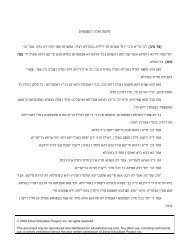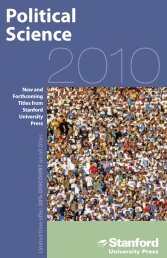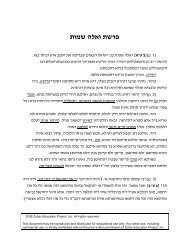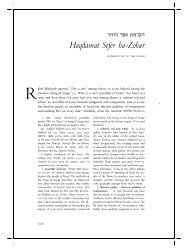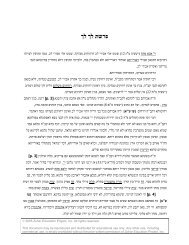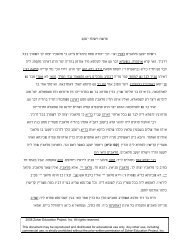Front Matter (PDF) - Stanford University Press
Front Matter (PDF) - Stanford University Press
Front Matter (PDF) - Stanford University Press
You also want an ePaper? Increase the reach of your titles
YUMPU automatically turns print PDFs into web optimized ePapers that Google loves.
eads it. This leads us closer to the real purpose of Zoharic exegesis. The<br />
who<br />
wants to take the reader inside the divine life. It wants ever to retell the<br />
Zohar<br />
of the ¯ow of the se®rot, their longings and union, the arousal of love<br />
story<br />
and the way in which that arousal causes blessingto ¯ow throughout the<br />
above<br />
This is the essential story of Kabbalah, and the Zohar ®nds it in verse<br />
worlds.<br />
verse, portion after portion, of the Torah text. But each retellingoffers a<br />
after<br />
and often startlingly different perspective. The Zohar is ever enrichingthe<br />
new<br />
narrative by means of retellingit from the vantage point of yet<br />
kabbalistic<br />
hermeneutic insight. On each page yet another verse, word, or tale of<br />
another<br />
Torah is opened or ``uncovered'' to reveal new insight into the great story<br />
the<br />
the Zohar, that which it proffers as the truth of the Torah, of the cosmos,<br />
of<br />
of the reader's soul.<br />
and<br />
the series of homilies by various speakers around a particular verse or<br />
In<br />
in the scriptural text, the Zohar takes its readers through multiple<br />
moment<br />
of understanding, reaching from the surface layer of ``plain'' meaning<br />
layers<br />
ever more profound revelations. A great love of language is revealed in<br />
into<br />
process; plays on words and subtle shadings of meaning often serve as<br />
this<br />
to a total recon®guration of the Scripture at hand. For this reason, the<br />
ways<br />
best readers, both traditional and modern, are those who share its<br />
Zohar's<br />
fascination with the mystery of words, includingboth their aural and<br />
endless<br />
(or ``spoken'' and ``written'') manifestations.<br />
graphic<br />
kabbalists contemporaneous with the Zohar were offeringmultile-<br />
Other<br />
readings of Scripture as well. Rabbi Baḥya ben Asher of Barcelona immediatelveled<br />
comes to mind. His Torah commentary, written in the 1290s, offers<br />
best example of the fourfold interpretation of Scripture in its Jewish form:<br />
the<br />
after verse is read ®rst for its plain meaning, then according to ``the way<br />
verse<br />
Midrash,'' followed by ``the way of intellect'' or philosophical allegory, and<br />
of<br />
``the way of Kabbalah.'' Rabbi Baḥya's work is in fact important as one<br />
®nally<br />
the earliest sources for quotations from the Zohar.<br />
of<br />
Zohar offers no such neat classi®cations. Insights offered by a group of<br />
The<br />
discussinga text may bounce back and forth from readings that<br />
``companions''<br />
be (and sometimes indeed are) found in earlier midrashic works to ways<br />
could<br />
readingthat belongwholly to the world of Kabbalah. Kabbalistic interpretations<br />
of<br />
are sometimes so well ``sewn'' into the midrashic fabric that the reader is<br />
wonderingwhether the kabbalistic referent might not indeed be the ``real''<br />
left<br />
a given biblical verse or rabbinic passage. In one well-known text,<br />
meaningof<br />
Zohar refers to mystical interpretations as the ``soul'' of Torah, distinguished<br />
the<br />
from the narrative that forms the outward ``garments'' and the legal<br />
that serve as Torah's ``body'' (playingon the phrase gufei Torah<br />
derivations<br />
of Torah''], that in rabbinic parlance means ``essential teachings'').<br />
[``bodies<br />
Introduction<br />
lviii<br />
text also suggests a further level of readings, the ``innermost soul'' of<br />
That<br />
that will not be fully revealed until messianic times. But when encoun-<br />
Torah<br />
teringactual passages from the Zohar, it is not easy to determine just where



